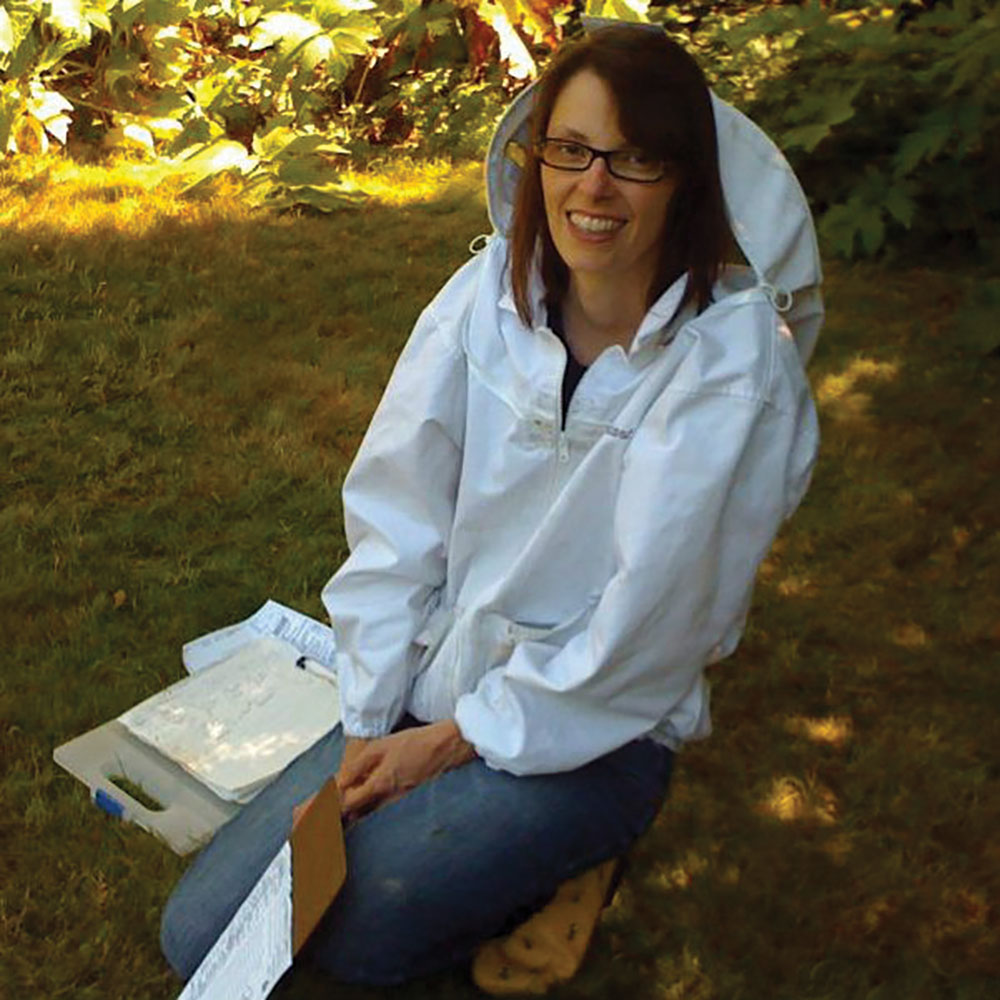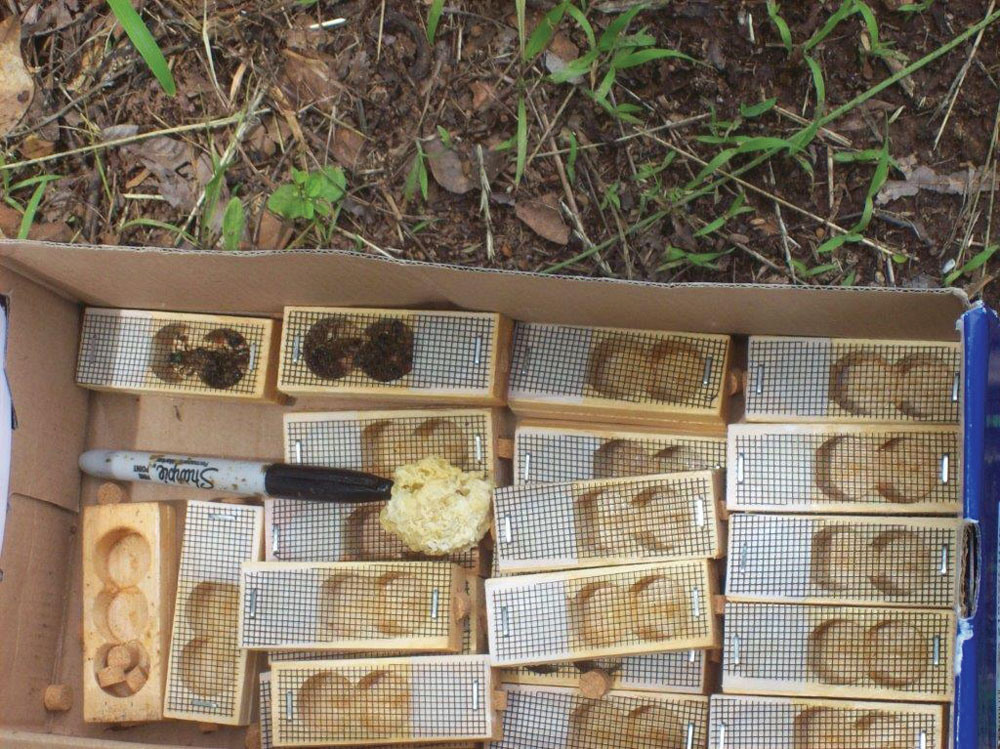by Morris Ostrofsky
Reconsidering your beekeeping goals is another way to continue keeping bees. Why not keep bees for the sheer enjoyment of keeping them? What better way to start the day than to sit in front of the hive with a cup of coffee/tea and just watch. Ask yourself, “Do I really need a dozen hives?”, “Do I really need to make more honey than my family consumes?”, “What else can I do with the wax?” Your answers to these questions can lead to less strenuous but equally satisfying beekeeping.
One way to keep your hand in beekeeping is to focus on raising nucs. Typically five-frame nuc boxes weigh very little. They are easy on your back, you can still enjoy keeping bees, and there is always a market for them. Another option is to simply harvest enough honey comb for your own family’s consumption. You do not have to extract and can leave most of the honey for the bees. This means no heavy lifting, no extracting and no marketing. An added bonus is little or no late winter feeding. Bill Greenrose, the New England beekeeper, has recently started to make lip balm and body creams. “From the standpoint of being a slowly aging beekeeper, I think these ‘other’ products are a nice alternative to the heavy lifting that goes with both pollination and honey production.”
Raising queens is another consideration. It is a challenging activity that requires knowledge of bee biology, weather conditions, plant phenology and general beekeeping skills. Again no heavy lifting is involved not to mention the queens are locally adapted. You can use the queens or sell them as there always seems to be a market for them.
At times something beyond aging changes our daily lives and therefore our ability to keep bees. Beekeepers are nothing less than creative and when faced with a disability find ways to adapt to the change in order to continue beekeeping.
I met Naomi Price at a laboratory workshop at a conference. She came rolling in on her own and was confidently ready to learn. This is consistent with Naomi’s approach to beekeeping. She wants the freedom to tend her bees without assistance from others. “Accessibility is all about attitude,” she says. After a couple years of working with the Langstroth hive, Naomi found she needed a different hive configuration. Living with paraplegia and restricted to lifting less than five pounds per arm, she wanted a hive that she could work independently without taking away from what the bees need.
Naomi’s background includes doing ADA accessibility work with county and city governments. Her quest for a more user friendly hive involved studying foraging, brood rearing, communication, food storage, ventilation, Winter clustering, pests, and even the local weather. She compared the histories of hive designs, read research papers, and factored in her own beekeeping experience. To all that, she added the requirements she needed for successful beekeeping.
The Valhalla hive is the result of Naomi’s research and consultation with The Hive Man, Richard Nichols. Naomi has used her Valhalla hive for two seasons. She says, “I still monitor and question every aspect of the Valhalla and probably will for several years to come.”
The Valhalla hive is based on the Tanzania design with modifications.
1) The hive can be set at any height.
2) The outer metal cover on the hive is attached to the body with hinges and is designed to require only five to eight pounds of force to open it.
3) The hive cover, that provides a barrier to the sun and wind, will not close unexpectedly due to a
clever latch system.
4) There are 24 deep foundationless Langstroth frames in the hive.
5) One frame can temporarily rest against the inside surface of the cover
6) Duck cloth is placed over the frames to protect them from the elements and robbing bees.
According to Naomi, “My five colonies are showing consistent approval for this hive design through all weather conditions, predators, robber attempts, while filling frames with brood, bee bread or honey.”
There is no need to lift boxes to do inspections or to store empty boxes during the Winter. The hive cover does not need to be removed for inspections because it is hinged on the front side. The side latch holds it open when working the hive.
Richard and Naomi continue to improve the Valhalla hive design. Richard sells the complete hive and hive plans. See references for contact information for Richard and the fabricator and supplier of the arm latch and metal cover.
Another example of adapting to changing circumstances is Krista Conner of Seattle. She has over eight years of beekeeping experience, is a certified Journeyman beekeeper in Washington State and is the most recent past President of Puget Sound Beekeepers Association. Krista says, “I hope this story ends up inspiring others to not let things stand in their way.” She became a beekeeper despite a major health issue; in this case cancer. “I used beekeeping as a topic to distract myself thru my surgery and treatments over the course of a year and set a goal for myself to start beekeeping at the end of it all as a reward.”
In 2011 cancer “reared its ugly head” again. Krista became physically disabled and unable to manage hives at all. “I reached out to my beekeeper friends at PSBA to help me finish out the year. (I’ve learned beekeepers are great in this regard – pitching in help).” During the Winter Krista focused on her health and looked toward the 2012 Spring beekeeping season as the light at the end of the tunnel. She says, “Again, this kinda crazy hobby became a welcome respite for me – something to focus upon besides the trials and tribulations of dealing with a major health crisis.”
Krista focused on what she did have and what she wanted to accomplish which was to continue beekeeping and gain strength and mobility. “This felt like the proverbial lemons to lemonade saying.” Her self-inventory revealed she had a decent level of knowledge of hive management, a strong skill set of project management and a willingness to share her knowledge.
Since 2012 Krista has run an apprentice program offering new beekeepers the chance to manage her 20+ hives while she tutors them along the way. “Overall I have found excitement and meaning in finding ways to help my apprentices learn how to keep bees.” Krista concludes, “So, there you have it, the highlights of how I’ve overcome some barriers to beekeeping and even how beekeeping has helped me overcome barriers in my life.”
To continue keeping bees we need to adapt to the changes that come with age or disability. There are many ways this can be accomplished if beekeepers keep one principle in mind. Charles Darwin sums it up the best when he said, “It’s not the strongest of the species that survives, nor the most intelligent that survives. It is the one that is the most adaptable to change.”
Bush Farms http://www.bushfarms.com/beeslazy.htm
Randy Oliver http://www.scientificbeekeeping.com
Magnifiers http://www.magnifier.com/headband_magnifier.htm
Beekeeping supplies http://www.mannlakeltd.com/beekeeping-supplies
Beekeeping supplies http://www.dadant.com/catalog/index.php?cPath=88unassembled 8 frame
Journals http://www.cafepress.com/+beekeepers+journals
Hive Tracks (electronic version) http://hivetracks.com
Safe lifting http://physicaltherapy.about.com/od/ergonomics/qt/SafeLifting.htm
Back strengthening exercises http://www.realsimple.com/health/fitness-exercise/workouts/4-back-strengthening-exercises/side-plank
Osteoarthritis http://www.mayoclinic.org/diseases-conditions/osteoarthritis/basics/treatment/con-20014749
Leg strengthening exercises http://healthyliving.azcentral.com/home-leg-strengthening-exercises-6286.html
Extra long hive tool http://www.kelleybees.com/Shop/12/Smokers-Tools/Tools/4636/Extra-Long-Hive-Tool
Instructions to cut down 10 to 8 frame western http://www.bushfarms.com/beeseightframemedium.htm
For plans or already constructed Valhalla hive (no delivery) – The Hive Man Richard Nichols 541-447-7907 richardtarsia@gmail.com
Fabricator and supplier of Valhalla hive arm latch and metal for outer cover – McAlister Industries Tim McAlister 541-610-5554 mcalister@cbbmail.com














